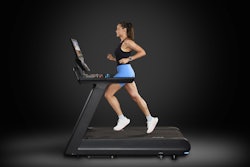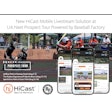SOURCE: American College of Sports Medicine (ACSM)
Statement includes 12 action steps for health care providers, healthy individuals and those recovering from COVID-19
(Indianapolis, IN) – The American College of Sports Medicine (ACSM) today published a call to action statement addressing COVID-19 and safely returning to sports and exercise. Authored by ACSM subject matter experts, the statement highlights the current science around COVID-19 and provides 12 action steps to consider. “COVID-19: Considerations for Sports and Physical Activity” is ACSM’s first call to action statement and published in the August issue of ACSM’s Current Sports Medicine Reports.
“ACSM has a long-standing history of translating science around sport and physical activity into practice,” said author and ACSM Past President Thomas M. Best, M.D., Ph.D., FACSM. “To date, most guidelines around COVID-19 and return to sport and physical activity have focused on high-level athletes. We use this statement to address gaps for the average healthy person to return to physical activity following a period of inactivity.”
ACSM call to action statements combine research evidence and expert opinion to bring attention to a current scientific or clinical need and highlight a series of actions that can be taken. In this statement, authors summarize the current scientific knowledge about COVID-19, its transmission and the negative effects of physical inactivity.
“The short- and long-term impact of inactivity negatively influences physical and mental health,” said coauthor and ACSM Past President William O. Roberts, M.D., M.S., FACSM. “Physical activity is critical to health outcomes and an essential component of weathering the pandemic.”
The statement also emphasizes the general benefits of exercise for individuals and how exercise contributes to healthy immune function. It includes actions that can be taken by health care providers and individuals.
“The effects of exercise on the immune system are well documented, and a thoughtful approach to return to sport and physical activity after a period of inactivity is critical,” adds Dr. Best. “Physicians are encouraged to speak to patients regarding their concerns about returning to physical activity, including the importance of social distancing and, where appropriate, wearing a mask. Telehealth should be considered as a way to reach patients and counsel them regarding the importance of physical activity during this pandemic.”
Through this new statement, ACSM offers these 12 actions to consider in the safe return to sports and exercise:
- Well individuals should start or continue moderate physical activity for 150 to 300 minutes a week; smaller amounts of physical activity are still beneficial.
- Individuals who had COVID-19 should consult with a primary care physician to determine a safe return to exercise.
- Exercise at home or outside while maintaining proper physical distance from others and using face coverings when needed to minimize droplet spread.
- Maintain immune health by participating in 150 to 300 minutes of moderate-to-vigorous physical activity a week and keeping bodyweight at recommended levels.
- High-risk individuals should refrain from exhaustive exercise, overreaching and overtraining.
- Determine evidence-based recommendations for return to exercise after resolution of COVID-19. In the interim, advise rest and no exercise for two weeks after resolution of mild or moderate COVID-19 or from a positive test followed by slowly resuming physical activity under close monitoring by health care team.
- Apply and adapt the World Health Organization interim guidelines, COVID-19 mitigation checklists and risk assessment tool kit to each sport discipline.
- Use innovative strategies in the approach to promote physical activity during COVID-19.
- Develop policies to safely reintroduce group activities that augment physical and mental health in close consideration of social determinants of health.
- Optimize sports medicine telehealth to have broad appeal and reach across diverse populations.
- Ensure equal access to telehealth across all communities and focus on reaching vulnerable populations, the economically disadvantaged and those with language barriers.
- Implement the use of masking and testing to reduce spread and avoid close contact when masking fails. When universal masking cannot occur (e.g., high intensity exercise, competitions), diagnostic testing and effective contact tracing protocols become increasingly important, especially in high-contact risk sports.
“Regular exercise improves physical and mental health and is safe when physically distanced, especially outdoors,” adds Dr. Roberts. “Moderate exercise improves your immune function and may be a factor in reducing your risk of contracting COVID-19. Indoors and outdoors with others around, masking may be the difference between staying healthy and getting sick. Remember the four D's for exercising around others during the pandemic: double the distance and don't draft.”
Visit https://www.acsm.org/acsm-positions-policy/official-positions/call-to-action-statements to view and download the paper.
About the American College of Sports Medicine
The American College of Sports Medicine is the largest sports medicine and exercise science organization in the world. More than 50,000 international, national and regional members are dedicated to advancing and integrating scientific research to improve educational and practical applications of exercise science and sports medicine. More details can be found at www.acsm.org































